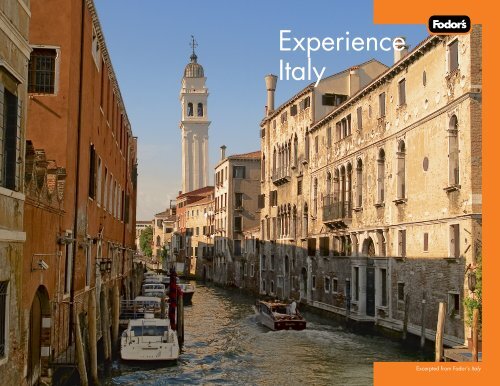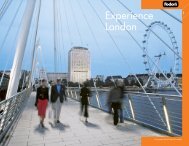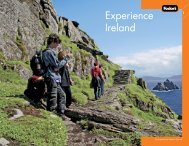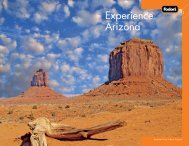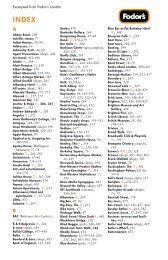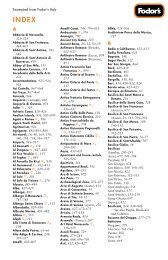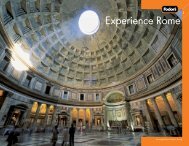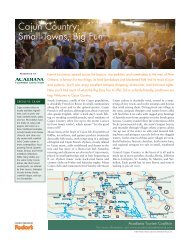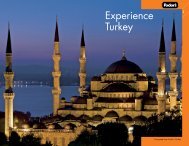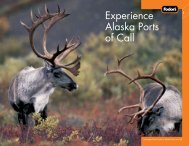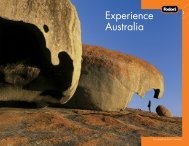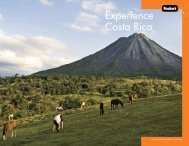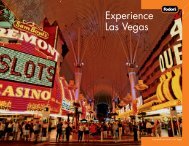You also want an ePaper? Increase the reach of your titles
YUMPU automatically turns print PDFs into web optimized ePapers that Google loves.
<strong>Experience</strong><br />
<strong>Italy</strong><br />
Excerpted from Fodor’s <strong>Italy</strong>
12 < <strong>Experience</strong> <strong>Italy</strong><br />
WHAT’S NEW<br />
Change comes slowly in the Bel Paese.<br />
There’s a certain romance to the idea<br />
that the historical centers of Rome or<br />
Florence would be easily recognizable to<br />
residents from Leonardo daVinci’s time.<br />
Tiny cars and whining scooters in Italian<br />
cities and towns maneuver narrow<br />
cobblestone streets designed for horses<br />
and carriages; many restaurants rely on<br />
well-practiced classic dishes that haven’t<br />
changed for centuries; and some of the<br />
world’s most magnificent classical architecture<br />
demands to be contemplated and<br />
studied rather than admired from the window<br />
of a passing vehicle.<br />
But that timeless quality is matched by<br />
other aspects of Italian culture that are<br />
thoroughly modern. A proud G-8 nation<br />
and a founding member of the European<br />
Union, <strong>Italy</strong> is active on the international<br />
stage and modernizing its economy in<br />
an increasingly global marketplace. Life<br />
is becoming faster paced and increasingly<br />
cosmopolitan. In numerous ways<br />
the country is indeed changing—perhaps<br />
faster than many Italians realize.<br />
150 Years of Unification<br />
In 1861, Giuseppe Garibaldi, the father<br />
of unified <strong>Italy</strong>, faced off in Sicily against<br />
Neapolitan forces determined to keep<br />
<strong>Italy</strong> a collection of disparate kingdoms.<br />
The story goes that Garibaldi turned to<br />
his lieutenant and said, “Here we either<br />
make <strong>Italy</strong>, or we die.”<br />
They didn’t die, and now, 150 years later,<br />
Garibaldi’s iconic campaign is held as the<br />
key turning point in the history of the<br />
country—the moment when the single<br />
state we know today was born. In 2011,<br />
throughout the country celebrations large<br />
and small will mark the sesquicentennial<br />
of Italian unification.<br />
The most vigorous—or at least the most<br />
organized—celebrations are planned for<br />
Turin, the city in the Piedmont region<br />
that served as unified <strong>Italy</strong>’s first capital.<br />
March 17 is unification day, but there are<br />
exhibitions and events scheduled throughout<br />
the year.<br />
Train Upgrades<br />
Some two decades after plans for a highspeed<br />
train network in <strong>Italy</strong> were first<br />
unveiled, and after more than €30 billion<br />
in expenditures, trains are moving faster.<br />
Thanks to the new Alta Velocità lines,<br />
which can reach top speeds of more than<br />
225 miles per hour, what was once a<br />
4½-hour train ride between Rome and<br />
Milan can now be made in less than three<br />
hours. Rome to Florence now takes 80<br />
minutes; Rome to Naples just over an<br />
hour. In 2011, new lines are set to open<br />
going farther south toward Bari and Reggio<br />
Calabria, and, eventually, into Sicily.<br />
An east-west line is in the works linking<br />
Milan to Venice and Trieste.<br />
The government is banking on the highspeed<br />
trains not only to link far-flung<br />
parts of the country more closely, but<br />
also to improve the environment by providing<br />
a more energy-efficient alternative<br />
to domestic air travel. For travelers from<br />
abroad, the faster service means it’s easier<br />
to see more of <strong>Italy</strong> on a single trip.<br />
Old vs. New<br />
For a country with a history as rich as<br />
<strong>Italy</strong>’s, perhaps it shouldn’t come as a surprise<br />
that when the present rubs up against<br />
the past, the result is lots of friction.<br />
This is true in many fields, ranging from<br />
architecture to art and from cuisine to<br />
popular culture. Even in the biggest, most<br />
cosmopolitan cities, modern art struggles<br />
to get a foothold. Sleek, contemporary<br />
bars and restaurants can have trouble<br />
developing a steady following, and experimental<br />
theater and dance troupes often<br />
fight for second billing.<br />
The most high-profile example of this phenomenon<br />
dates from 2006, when the Ara<br />
Pacis museum—the first significant civic<br />
building project in Rome since World War<br />
II—opened along the Tiber near the pre-<br />
Christian Mausoleum of Augustus and<br />
the massive Fascist-era Piazza Augusto<br />
Imperatore. The glass-and-metal structure<br />
from Pritzker Prize–winning architect<br />
Richard Meier is an unexpected display of<br />
modernity in the midst of Rome’s historic<br />
city center. To many Italians it’s an eyesore,<br />
as well as a rich topic for conversation<br />
and debate.<br />
Film Festivals<br />
At its peak, the Italian film industry was<br />
among the most respected in the world.<br />
<strong>Italy</strong> has still won more Oscars for foreign-language<br />
films than any other country,<br />
and the impact that renowned Italian<br />
maestros like Fellini, Rossellini, Antonioni,<br />
and de Sica have had on the film<br />
industry would be hard to overstate.<br />
Notwithstanding occasional gems, <strong>Italy</strong>’s<br />
present-day film industry falls short of its<br />
heyday. But when it comes to film festivals,<br />
<strong>Italy</strong> is moving stronger than ever.<br />
The Venice Film Festival, started in 1932,<br />
is the oldest such festival in the world and<br />
has long been known for its innovative<br />
lineup, as well as more than its fair share<br />
of glitz and glamour. Since its origin in<br />
2006, the plucky Rome International<br />
Film Festival has made a place for itself,<br />
while more established events such as<br />
the Taormina Film Festival in Sicily and<br />
northern <strong>Italy</strong>’s Turin Film Festival have<br />
grown in international importance.<br />
All told, it’s believed that <strong>Italy</strong> now has<br />
more film festivals than any other country.<br />
What’s New<br />
> 13<br />
In 2010, only four days on the calendar<br />
did not have at least one festival taking<br />
place somewhere in the country.<br />
Religion<br />
Rome is still the spiritual home of the<br />
world’s 1.1 billion Catholics, but church<br />
attendance in <strong>Italy</strong> has been eroding since<br />
the 1950s, and today only about one in<br />
five Italians attends church regularly.<br />
Nonetheless, religion maintains a powerful<br />
hold on Italian culture, with the<br />
Church regularly weighing in on political<br />
and social issues. Churches themselves<br />
remain a centerpiece of almost every Italian<br />
town, with the church on the main<br />
square the de facto meeting place for<br />
locals.<br />
While church attendance slips, religion<br />
remains a hot topic in <strong>Italy</strong> as citizens<br />
react to increasing immigration from<br />
North Africa, Eastern Europe, Asia, the<br />
Middle East, and elsewhere. Today, there<br />
are more different religions in <strong>Italy</strong> than<br />
at any point since Roman times—with<br />
Muslims, Protestants, Buddhists, Christian<br />
Orthodox, Jews, Scientologists, and<br />
Mormons all present in significant numbers.<br />
All told, a little over one in seven<br />
Italian residents is non-Catholic.
14 <<br />
WHAT’S<br />
WHERE<br />
1Rome. <strong>Italy</strong>’s capital is one<br />
of the great cities of Europe.<br />
It’s a large, busy metropolis<br />
that lives in the here and now,<br />
yet there’s no other place on<br />
earth where you’ll encounter<br />
such powerful evocations of<br />
a long and spectacular past,<br />
from the Colosseum to the<br />
dome of St. Peter’s.<br />
2Northern <strong>Italy</strong>. The prosperous<br />
north has <strong>Italy</strong>’s most<br />
sophisticated culture and<br />
its most diverse landscape.<br />
Venice is a rare jewel of a<br />
city, while Milan and Turin<br />
are centers of commerce and<br />
style. Along the country’s<br />
northern border, the mountain<br />
peaks of the Dolomites and<br />
Valle d’Aosta attract skiers<br />
in winter and hikers in summer,<br />
while the Lake District<br />
and the coastline of the<br />
Riviera are classic summertime<br />
playgrounds. Food here<br />
is also exceptional, from the<br />
French-influenced cuisine of<br />
Piedmont to Italian classics<br />
prepared with unrivaled skill<br />
in Emilia-Romagna.<br />
3Central <strong>Italy</strong>. No place<br />
better epitomizes the greatness<br />
of the Renaissance than<br />
Florence, where there’s a<br />
masterpiece around every corner,<br />
from Michelangelo’s David<br />
to Botticelli’s Venus. Elsewhere,<br />
the central regions of Tuscany<br />
and Umbria are characterized<br />
by midsize cities and<br />
small hilltop towns, each with<br />
its own rich history and art<br />
treasures. Highlights include<br />
the walled city of Lucca;<br />
Pisa and its Leaning Tower;<br />
Siena, home of the Palio; and<br />
Assisi, the city of St. Francis.<br />
In between, the gorgeous<br />
countryside produces some of<br />
<strong>Italy</strong>’s finest wine.<br />
4Southern <strong>Italy</strong>. The region<br />
of Campania is a popular<br />
place both to unwind—on<br />
the pint-size island of Capri<br />
or the resort towns of the<br />
Amalfi Coast—and to explore<br />
the past—at the archaeological<br />
ruins of Pompeii,<br />
Herculaneum, and Paestum.<br />
In the middle of everything<br />
is the vibrant, chaotic city of<br />
Naples. Farther south, in the<br />
off-the-beaten-path regions<br />
of Puglia, Basilicata, and<br />
Calabria, you’ll find attractive<br />
beaches, mysterious ancient<br />
dwellings, and the charming<br />
town of Lecce. Across a<br />
narrow strait from Calabria<br />
is Sicily. Baroque churchhopping<br />
could be a sport on<br />
the cacophonous streets of<br />
Palermo and Siracusa, while<br />
amid the almond groves of<br />
Agrigento there stands one<br />
of the world’s best-preserved<br />
Greek ruins.<br />
Lake<br />
Bolzano<br />
FRIULI-VENEZIA<br />
GIULIA<br />
Como<br />
Trento<br />
Lake<br />
Aosta Lake<br />
Garda<br />
S L O V E N I A<br />
VALLE Maggiore<br />
Bergamo<br />
Treviso<br />
D'AOSTA<br />
Vicenza<br />
Turin<br />
Milan<br />
Verona Padua Venice<br />
Gulf of<br />
C R O AT I A<br />
Ferrara Venice<br />
Parma<br />
Bologna<br />
EMILIA-ROMAGNA Ravenna<br />
Genoa<br />
S A N M A R I N O<br />
F R A N C E<br />
Florence<br />
Arezzo<br />
Ancona<br />
M O N A C O<br />
Modena<br />
Lake<br />
Bolzano<br />
FRIULI-VENEZIA<br />
GIULIA<br />
Como<br />
Lugano<br />
Trento<br />
MT.<br />
Lake<br />
Udine<br />
BLANC Aosta Lake<br />
Garda<br />
S L O V E N I A<br />
VALLE Maggiore Como Bergamo<br />
Treviso<br />
Trieste<br />
D'AOSTA<br />
Vicenza<br />
Turin<br />
Milan 2<br />
Pavia<br />
Verona Padua Venice<br />
Gulf of<br />
C R O AT I A<br />
Asti<br />
Ferrara Venice<br />
Parma<br />
Bologna<br />
EMILIA-ROMAGNA Ravenna<br />
Genoa<br />
Rimini<br />
La Spezia<br />
Pistoia 3 S A N M A R I N O<br />
F R A N C E<br />
Lucca<br />
San<br />
Florenceence<br />
SAN MARINO<br />
Remo<br />
Pisa<br />
Arezzo<br />
Ancona<br />
M O N A C O<br />
Livorno<br />
Modena<br />
MT.<br />
Lugano<br />
Udine<br />
BLANC<br />
Como<br />
Trieste<br />
2<br />
Pavia<br />
Asti<br />
Rimini<br />
La Spezia<br />
Pistoia 3<br />
Lucca<br />
San<br />
ence SAN MARINO<br />
Remo<br />
Pisa<br />
Livorno<br />
A L P I<br />
A L P I<br />
Elevation<br />
15,577<br />
10,825<br />
9,840<br />
8,860<br />
7,875<br />
6,900<br />
5,900<br />
4,920<br />
3,940<br />
2,920<br />
1,970<br />
980<br />
490<br />
250<br />
100<br />
feet<br />
Po Po<br />
PIEDMONT<br />
PIEDMONT<br />
A L GAE RL GI AE<br />
R I A<br />
Po Po<br />
LIGURIA<br />
a<br />
a<br />
e<br />
e<br />
S<br />
S<br />
n<br />
n<br />
a<br />
a<br />
i<br />
i<br />
r<br />
r<br />
u<br />
u<br />
g i<br />
g<br />
L<br />
i L<br />
Sassari Sassari<br />
Elevation<br />
15,5774,748<br />
4,748<br />
10,8253,300<br />
3,300<br />
9,8403,000<br />
3,000<br />
8,8602,700<br />
2,700<br />
7,8752,400<br />
2,400<br />
6,9002,100<br />
2,100<br />
5,9001,800<br />
1,800<br />
4,9201,500<br />
1,500<br />
3,9401,200<br />
1,200<br />
2,920900<br />
900<br />
1,970600<br />
600<br />
980300<br />
300<br />
490150<br />
150<br />
25075<br />
75<br />
10030<br />
30<br />
feetmeters<br />
meters<br />
LIGURIA<br />
RIVIERA<br />
A L P I<br />
A L P I<br />
RIVIERA<br />
CORSICA CORSICA<br />
Olbia Olbia<br />
S A RSD AI NR DI AI<br />
N I A<br />
SARDINIA SARDINIA<br />
Cagliari Cagliari<br />
LOMBARDY<br />
LOMBARDY<br />
Arno Arno<br />
A U SAT RU ISA T R I A<br />
Tiber<br />
T y r<br />
T y<br />
r<br />
r r<br />
h<br />
h<br />
e<br />
e<br />
n<br />
n<br />
i<br />
i<br />
a<br />
a<br />
n<br />
n<br />
S<br />
S<br />
e<br />
e<br />
a<br />
a<br />
a<br />
a<br />
e<br />
e<br />
S<br />
S<br />
n<br />
n<br />
a<br />
a<br />
e<br />
e<br />
n<br />
n<br />
a<br />
a<br />
r<br />
r<br />
r<br />
r<br />
e<br />
e t<br />
t<br />
i<br />
i<br />
d<br />
d<br />
e e M M<br />
TUNIS TUNIS<br />
T U NTI SU INA I S I A<br />
TRENTINO-ALTO ADIGE<br />
TRENTINO-ALTO ADIGE<br />
THE DOLOMITES<br />
TUSCANY<br />
VENETO<br />
VENETO<br />
THE DOLOMITES<br />
TUSCANY<br />
Tiber<br />
1<br />
THE MARCHES<br />
UMBRIA<br />
Terni Terni<br />
Tivoli Tivoli<br />
ROME ROME<br />
EGADI EGADI<br />
ISLANDS ISLANDS<br />
THE MARCHES<br />
Siena Siena Assisi Assisi<br />
Perugia Perugia<br />
ELBA ELBA<br />
Orvieto Orvieto<br />
1<br />
UMBRIA<br />
LATIUM<br />
LATIUM<br />
A d r<br />
A<br />
i<br />
d r i<br />
a<br />
a<br />
t<br />
t<br />
i<br />
i<br />
c<br />
c<br />
S e<br />
S e<br />
a<br />
a<br />
ABRUZZO ABRUZZO<br />
Naples Naples<br />
CAMPANIA<br />
CAMPANIA<br />
What’s H U NHG Where UAN RGY A R> Y15<br />
B O SBN OI AS<br />
N I A<br />
A N DA<br />
N D<br />
H E R HZ E GR ZO EVG I NO AV<br />
I N A<br />
CALABRIA<br />
M O NM TOE N TE EG NR EO G R O<br />
PUGLIA<br />
PUGLIA<br />
VESUVIUS VESUVIUS<br />
Brindisi Brindisi<br />
Potenza Potenza<br />
ISCHIA ISCHIA<br />
Amalfi Amalfi<br />
Lecce Lecce<br />
CAPRI CAPRI<br />
BASILICATA BASILICATA Taranto Taranto<br />
Paestum Paestum<br />
Gulf of Gulf of<br />
Taranto Taranto<br />
Agrigento Agrigento<br />
PANTELLERIA PANTELLERIA<br />
Pescara Pescara<br />
MOLISE MOLISE Foggia Foggia<br />
AEOLIAN AEOLIAN<br />
ISLANDS ISLANDS<br />
Messina Messina<br />
Palermo Palermo<br />
Reggio Reggio<br />
ETNA ETNA<br />
SICILY SICILY<br />
S I C ISLY I C I LY<br />
4<br />
4<br />
Catania Catania<br />
Siracusa Siracusa<br />
Bari Bari<br />
Cosenza Cosenza<br />
CALABRIA<br />
Catanzaro Catanzaro<br />
I o n i a n S e a<br />
I o n i a n S e a<br />
0 0 100 miles 100 miles<br />
0 0 150 km150<br />
km
16 < <strong>Experience</strong> <strong>Italy</strong><br />
ITALY<br />
PLANNER<br />
Getting Here<br />
The major gateways to <strong>Italy</strong> are<br />
Rome’s Aeroporto Leonardo da<br />
Vinci (FCO), better known as<br />
Fiumicino, and Milan’s Aeroporto<br />
Malpensa (MAL). There<br />
are some direct flights to secondary<br />
airports, primarily Venice<br />
and Pisa, but to fly into most<br />
other Italian cities you need to<br />
make connections at Fiumicino,<br />
Malpensa, or another European<br />
hub. You can also take the FS<br />
airport train to Rome’s Termini<br />
station or a bus to Milan’s central<br />
train station (Centrale) and<br />
catch a train to any other location<br />
in <strong>Italy</strong>. It will take about<br />
one hour to get from either<br />
Fiumicino or Malpensa to the<br />
train station.<br />
<strong>Italy</strong>’s airports are not known<br />
for being new or efficient.<br />
They all have restaurants and<br />
snack bars, and there is Internet<br />
access. Each airport has at least<br />
one nearby hotel. Ramped-up<br />
security measures may include<br />
random baggage inspection<br />
and bomb-detection dogs. In<br />
the case of Florence and Pisa,<br />
the city centers are only a<br />
15-minute taxi ride away—so<br />
if you encounter a long delay,<br />
spend it in town.<br />
For further information about<br />
getting where you want to go,<br />
see “Getting Here” at the beginning<br />
of each part section of this<br />
book.<br />
What to Pack<br />
In summer, stick with light clothing, as things can get<br />
steamy in June, July, and August. But throw in a sweater<br />
in case of cool evenings, especially if you’re headed for<br />
the mountains and/or islands. Sunglasses, a hat, and sunblock<br />
are essential. Brief summer afternoon thunderstorms<br />
are common in inland cities, so an umbrella will come in<br />
handy. In winter, bring a coat, gloves, hats, scarves, and<br />
boots. In winter, weather is generally milder than in the<br />
northern and central United States, but central heating may<br />
not be up to your standards, and interiors can be cold and<br />
damp; take wools or flannel rather than sheer fabrics. Bring<br />
sturdy shoes for winter and comfortable walking shoes in<br />
any season.<br />
As a rule, Italians dress exceptionally well. They do not usually<br />
wear shorts. Men aren’t required to wear ties or jackets<br />
anywhere, except in some of the grander hotel dining<br />
rooms and top-level restaurants, but are expected to look<br />
reasonably sharp—and they do. Formal wear is the exception<br />
rather than the rule at the opera nowadays, though<br />
people in expensive seats usually do get dressed up.<br />
A certain modesty of dress (no bare shoulders or knees) is<br />
expected in churches, and strictly enforced in many.<br />
For sightseeing, pack a pair of binoculars; they will help<br />
you get a good look at painted ceilings and domes. If you<br />
stay in budget hotels, take your own soap. Many such<br />
hotels do not provide it, or they give guests only one tiny<br />
bar per room. Washcloths, also, are rarely provided even<br />
in three- and four-star hotels.<br />
Restaurants: The Basics<br />
A full meal in <strong>Italy</strong> has traditionally consisted of five<br />
courses, and every menu you encounter will still be organized<br />
along some version of this five-course plan:<br />
MFirst up is the antipasto (appetizer), often consisting of<br />
cured meats or marinated vegetables. Next to appear is<br />
the primo, usually pasta or soup, and after that the secondo,<br />
a meat or fish course with, perhaps, a contorno (vegetable<br />
dish) on the side. A simple dolce (dessert) rounds out<br />
the meal.<br />
MThis, you’ve probably noticed, is a lot of food. Italians<br />
have noticed as well—a full, five-course meal is an indulgence<br />
usually reserved for special occasions. Instead, restaurant<br />
meals are a mix-and-match affair: you might order<br />
a primo and a secondo, or an antipasto and a primo, or a<br />
secondo and a contorno.<br />
MThe crucial rule of restaurant dining is that you should<br />
order at least two courses. It’s a common mistake for tourists<br />
to order only a secondo, thinking they’re getting a<br />
“main course” complete with side dishes. What they wind<br />
up with is one lonely piece of meat.<br />
Hotels: The Basics<br />
Hotels in <strong>Italy</strong> are usually well maintained (especially if<br />
they’ve earned our recommendation in this book), but in<br />
some respects they won’t match what you find at comparably<br />
priced U.S. lodgings. Keep the following points in mind<br />
as you set your expectations, and you’re likely to have a<br />
good experience:<br />
MFirst and foremost, rooms are usually smaller, particularly<br />
in cities. If you’re truly cramped, ask for another room, but<br />
don’t expect things to be spacious.<br />
MA “double bed” is commonly two singles pushed together.<br />
MIn the bathroom, tubs are not a given—request one if it’s<br />
essential. In budget places, showers sometimes use a drain<br />
in the middle of the bathroom floor. And washcloths are a<br />
rarity.<br />
MMost hotels have satellite TV, but there are fewer channels<br />
than in the United States, and only one or two will be in<br />
English.<br />
MDon’t expect wall-to-wall carpeting. Particularly outside<br />
the cities, tile floors are the norm.<br />
<strong>Italy</strong> Planner<br />
Speaking the<br />
Language<br />
> 17<br />
In most cities and many towns,<br />
you won’t have a hard time<br />
finding locals who speak at<br />
least rudimentary English. Odds<br />
are if the person you want to<br />
talk with doesn’t know English,<br />
there will be someone within<br />
earshot who can help translate.<br />
The farther south you travel, the<br />
fewer English speakers you’ll<br />
encounter, but if nothing else<br />
someone at your hotel will<br />
know a few words. No matter<br />
where in <strong>Italy</strong> you’re going,<br />
if you learn some common<br />
phrases in Italian, your effort<br />
will be appreciated.<br />
<strong>Italy</strong> from Behind<br />
the Wheel<br />
Americans tend to be well<br />
schooled in defensive-driving<br />
techniques. Many Italians are<br />
not. When you hit the road,<br />
don’t be surprised to encounter<br />
tailgating and high-risk passing.<br />
Your best response is to take<br />
the same safety-first approach<br />
you use at home. On the upside,<br />
<strong>Italy</strong>’s roads are very well maintained.<br />
Note that wearing a seat<br />
belt and having your lights on<br />
at all times are required by law.<br />
Bear in mind that a vehicle in<br />
Italian cities is almost always a<br />
liability, but outside of the cities<br />
it’s often crucial. An effective<br />
strategy is to start and end<br />
your Italian itinerary in major<br />
cities, car-free, and to pick up<br />
wheels for countryside touring<br />
in between.
18 < <strong>Experience</strong> <strong>Italy</strong><br />
ITALY TODAY<br />
. . . is eating well<br />
The old joke says that three-quarters of the<br />
food and wine served in <strong>Italy</strong> is good . . .<br />
and the rest is amazing. If that’s true, the<br />
“good” 75% is getting even better.<br />
<strong>Italy</strong> is home of one of the world’s greatest<br />
cuisines, so it may seem disingenuous to<br />
claim that it’s improving—but it clearly<br />
is. Ingredients that in the past were available<br />
only to the wealthy can now be found<br />
even in the remotest parts of the country<br />
at reasonable prices. Dishes originally<br />
conceived to make the most of inferior<br />
cuts of meat or the least flavorful part of<br />
vegetables are now made with the best.<br />
The same is true of Italian wine. A generation<br />
ago, the omnipresent straw-basket<br />
Chianti was a mainstay of pizzerias<br />
around the world, but the wine inside was<br />
often watery and insipid. Today, through<br />
investment and experimentation, <strong>Italy</strong>’s<br />
winemakers are figuring out how to get<br />
the most from their gorgeous vineyards.<br />
It’s fair to say that <strong>Italy</strong> now produces<br />
more types of high-quality wine from<br />
more different grape varieties than any<br />
other country in the world.<br />
Italian restaurateurs are keeping up with<br />
the changes. Though quaint family-run<br />
trattorias with checkered tablecloths, traditional<br />
dishes, and informal atmosphere<br />
are still common, there’s no doubt that<br />
they are on the decline. And nearly every<br />
town has a newer eatery with matching<br />
flatware, a proper wine list, and an innovative<br />
menu.<br />
. . . is passionate about soccer<br />
Soccer stands without rival as the national<br />
sport of <strong>Italy</strong>, but recent years have seen<br />
some changes to the beautiful game. On<br />
the positive side, <strong>Italy</strong> won its fourth<br />
World Cup in 2006, giving the country<br />
more world titles than any other this side<br />
of Brazil. But since then, soccer lovers<br />
have digested a series of unwelcome developments<br />
involving alleged match fixing,<br />
backroom deals for television contracts,<br />
drug scandals among players, and a rising<br />
level of violence between rival fans.<br />
Italian professional soccer leagues are trying<br />
to put those issues behind them and<br />
focus on on-the-field play, where the Italian<br />
leagues rank with England and Spain<br />
as the best in Europe. One emerging positive<br />
trend is geographic parity. After several<br />
years of the top Serie A league being<br />
dominated by northern teams, along with<br />
a handful from the central part of the<br />
country, success recently has been spread<br />
more evenly around, much to the joy of<br />
soccer-mad fans from the south.<br />
. . . endures ongoing political upheaval<br />
The political landscape in <strong>Italy</strong> is less<br />
stable than in any other industrialized<br />
nation. The country has endured a new<br />
government an average of about once a<br />
year since the end of World War II, and<br />
hopes are slim that the situation will<br />
change much in the near future.<br />
This virtual turnstile outside the prime<br />
minister’s office takes its toll on <strong>Italy</strong>:<br />
economic growth is slow in part because<br />
businesses are continually adapting to<br />
new government policies, and polls show<br />
that rank-and-file Italians are increasingly<br />
cynical about their political institutions.<br />
As a result, they’re much less likely to<br />
trust in or depend on the government than<br />
neighbors elsewhere in Europe do.<br />
. . . is getting older<br />
<strong>Italy</strong> is the oldest country in Europe<br />
(worldwide, only Japan is older)—the<br />
result of its low birth rate, relatively strict<br />
immigration standards, and one of the<br />
highest life expectancy rates in the world.<br />
As of 2010, the average Italian was 42.9<br />
years old, and the number keeps rising.<br />
The result is a remarkably stable population:<br />
the total number of Italian residents<br />
barely rises most years, and, according to<br />
the most recent estimates, is projected to<br />
start contracting by 2020. But the situation<br />
is putting a strain on the country’s<br />
pension system and on families, since<br />
elderly family members are likely to live<br />
with their children or grandchildren in a<br />
country where nursing homes are rare.<br />
The trend also has an impact on other<br />
areas, including politics (where older<br />
politicians are eager to promote policies<br />
aimed at older voters), the popular culture<br />
(where everything from fashion to<br />
television programming takes older consumers<br />
into consideration), and a kind of<br />
far-reaching nostalgia; thanks to a long<br />
collective memory, it’s common to hear<br />
even younger Italians celebrate or rue<br />
something that happened 50 or 60 years<br />
earlier as if it had just taken place.<br />
. . . lives with a black-market economy<br />
Nobody knows how big <strong>Italy</strong>’s blackmarket<br />
economy is, though experts all<br />
agree it’s massive. Estimates place it at<br />
anywhere from a fourth to a half of the<br />
official, legal economy.<br />
Put another way, if the highest estimates<br />
are correct, <strong>Italy</strong>’s black market is about<br />
as large as the entire economy of Switzerland<br />
or Indonesia. If the estimated<br />
black-market figures were added to the<br />
official GDP, <strong>Italy</strong> would likely leapfrog<br />
France, the U.K., and China to become<br />
the world’s fourth-largest economy.<br />
The presence of the black market isn’t<br />
obvious to the casual observer, but whenever<br />
a customer is not given a printed<br />
receipt in a store or restaurant, tobacco<br />
without a tax seal is bought from a street<br />
<strong>Italy</strong> Today<br />
> 19<br />
seller, or a product or service is exchanged<br />
for another product or service, that means<br />
the transaction goes unrecorded, unreported,<br />
and untaxed.<br />
. . . has a growing parks system<br />
<strong>Italy</strong> boasts 25 national parks covering<br />
a total of around 1.5 million hectares<br />
(58,000 square mi), or about 5% of the<br />
entire surface area of the country—more<br />
than twice as much as 25 years ago. And<br />
a new park is added or an existing park<br />
is expanded every few months.<br />
Part of the reason for the expansion has<br />
been a growing environmental movement<br />
in <strong>Italy</strong>, which has lobbied the government<br />
to annex undeveloped land for parks, thus<br />
protecting against development. But the<br />
trend is a boon for visitors and nature<br />
lovers, who can enjoy huge expanses of<br />
unspoiled territory.<br />
. . . is staying home in August<br />
<strong>Italy</strong> used to be the best example of<br />
Europe’s famous August exodus—where<br />
city dwellers would spend most of the<br />
month at the seaside or in the mountains,<br />
leaving the cities nearly deserted. Today,<br />
the phenomenon continues but is much<br />
less prevalent, as economic pressures<br />
have forced companies to keep operating<br />
through August. As a result, vacations are<br />
more staggered and vacationers’ plans are<br />
often more modest.<br />
The loss of shared vacation time for Italian<br />
workers can be an advantage for visitors,<br />
both because in August there is more<br />
room at the seaside and in the mountains,<br />
and because cities have taken to promoting<br />
local events designed to appeal to residents<br />
who are staying put. These days,<br />
summers in <strong>Italy</strong> boast a plethora of outdoor<br />
concerts and plays; longer restaurant<br />
and museum hours; and food, wine, and<br />
culture fairs.
20 < <strong>Experience</strong> <strong>Italy</strong><br />
ITALY<br />
TOP ATTRACTIONS<br />
B<br />
The Vatican<br />
(A) The home of the Catholic Church, a<br />
tiny independent state tucked within central<br />
Rome, holds some of the city’s most<br />
spectacular sights, including St. Peter’s<br />
Basilica, the Vatican Museums, and<br />
Michelangelo’s Sistine Chapel ceiling.<br />
(FChapter 1.)<br />
Ancient Rome<br />
(B) The Colosseum and the Roman Forum<br />
are remarkable ruins from Rome’s ancient<br />
past. Sitting above it all is the Campidoglio,<br />
with a piazza designed by Michelangelo<br />
and museums containing one of the<br />
world’s finest collections of ancient art.<br />
(FChapter 1.)<br />
Venice’s Grand Canal<br />
A trip down Venice’s “Main Street,”<br />
whether by water bus or gondola, is a signature<br />
Italian experience. (FChapter 3.)<br />
C<br />
A<br />
D<br />
Palladio’s Villas and Palazzi<br />
The 16th-century genius Andrea Palladio<br />
is one of the most influential figures in the<br />
history of architecture. You can visit his<br />
creations in his hometown of Vicenza, in<br />
and around Venice, and outside Treviso.<br />
(FChapter 4.)<br />
Galleria degli Uffizi, Florence<br />
The Uffizi—Renaissance art’s hall of<br />
fame—contains masterpieces by Leonardo,<br />
Michelangelo, Raphael, Botticelli,<br />
Caravaggio, and dozens of other luminaries.<br />
(FChapter 10.)<br />
Duomo, Florence<br />
(C) The massive dome of Florence’s Cathedral<br />
of Santa Maria del Fiore (aka the<br />
Duomo) is one of the world’s great feats<br />
of engineering. (FChapter 10.)<br />
H<br />
Piazza del Campo, Siena<br />
(D) Siena is Tuscany’s classic medieval<br />
hill town, and its heart is the Piazza del<br />
Campo, the beautiful, one-of-a-kind town<br />
square. (FChapter 11.)<br />
Basilica di San Francesco, Assisi<br />
(E) The giant basilica—made up of two<br />
churches, one built on top of the other—<br />
honors St. Francis with its remarkable<br />
fresco cycles. (FChapter 12.)<br />
Palazzo Ducale, Urbino<br />
No other building better exemplifies the<br />
principles and ideals of the Renaissance<br />
than this palace in the Marches region,<br />
east of Umbria. (FChapter 12.)<br />
The Ruins of Pompeii<br />
(F) When Vesuvius erupted in AD 79, its<br />
fallout froze the town of Pompeii in time.<br />
Walking its streets brings antiquity to life.<br />
(FChapter 13.)<br />
F<br />
G<br />
<strong>Italy</strong> Top Attractions<br />
E<br />
> 21<br />
Ravello, on the Amalfi Coast<br />
(G) Nowhere else better captures the<br />
essence of the gorgeous Amalfi Coast<br />
than Ravello. Perched high above the<br />
Tyrrhenian Sea, it’s the place to go for<br />
your blissful la dolce vita moment.<br />
(FChapter 13.)<br />
Lecce, Puglia<br />
With its lavish baroque architecture and<br />
engaging street life, Lecce takes the prize<br />
for the most appealing town in <strong>Italy</strong>’s<br />
deep south. (FChapter 14.)<br />
Valle dei Templi, Sicily<br />
(H) The Greek influence in Sicily dates to<br />
ancient days, as born out by these wellpreserved<br />
temple ruins. (FChapter 15.)
22 < <strong>Experience</strong> <strong>Italy</strong><br />
TOP EXPERIENCES<br />
Church Going<br />
Few images are more identifiable with<br />
<strong>Italy</strong> than the country’s great churches,<br />
amazing works of architecture that often<br />
took centuries to build. The name Duomo<br />
(derived from the Latin for “house,”<br />
domus, and the root of the English<br />
“dome”) is used to refer to the principal<br />
church of a town or city. Generally speaking,<br />
the bigger the city, the more splendid<br />
its duomo. Still, impressive churches<br />
inhabit some unlikely places—in the<br />
Umbrian hill towns of Assisi and Orvieto,<br />
for example (FChapter 12).<br />
In Venice, the Byzantine-influenced Basilica<br />
di San Marco (FChapter 3) is a testament<br />
to the city’s East-meets-West character.<br />
Milan’s Duomo (FChapter 6) is the largest,<br />
most imposing Gothic cathedral in<br />
<strong>Italy</strong>. The spectacular dome of Florence’s<br />
Duomo (FChapter 10) is a work of engineering<br />
genius. The Basilica di San Pietro in<br />
Rome (FChapter 1) has all the grandeur<br />
you’d expect from the seat of the Catholic<br />
Church. And <strong>Italy</strong>’s classical past is<br />
on display at Siracusa’s Duomo (FChapter<br />
15), which incorporates the columns of a<br />
6th-century-BC Greek temple.<br />
Driving the Back Roads<br />
If you associate Italian roads with unruly<br />
motorists and endless traffic snarls, you’re<br />
only partly right. Along the rural back<br />
roads, things are more relaxed. You might<br />
stop on a lark to take a picture of a crumbling<br />
farmhouse, have a coffee in a timefrozen<br />
hill town, or enjoy an epic lunch at<br />
a rustic agriturismo inaccessible to public<br />
transportation. Driving, in short, is the<br />
best way to see <strong>Italy</strong>.<br />
Among the countless beautiful drives,<br />
these are three of the most memorable:<br />
the legendary mountain ascent on SS48,<br />
the Grande Strada delle Dolomiti (FChapter<br />
5), takes you through the heart of the<br />
Dolomites, the famous Passo di Sella, and<br />
into the Val Gardena, passing unforgettable,<br />
craggy-peaked views. Every time<br />
the A1 autostrada tunnels through the<br />
mountains, this smaller SS1, Via Aurelia<br />
(FChapter 8), stays out on the jagged<br />
coastline of the Italian Riviera, passing<br />
terraced vineyards, cliff-hanging villages,<br />
and shimmering seas. SS222, the Strada<br />
Chiantigiana (FChapter 11), between<br />
Florence and Siena meanders through<br />
classic Tuscan landscapes. Be aware that<br />
Italian roads are often poorly marked. It<br />
helps to know a little geography, as many<br />
signs indicate the town the road leads to,<br />
but not what the road number is.<br />
Hiking the Hills<br />
Even if you don’t fancy yourself a disciple<br />
of Reinhold Messner (the favorite son of<br />
the Dolomites and the first man to reach<br />
the peak of Everest without oxygen),<br />
you’ll find great summer hiking aplenty<br />
all over <strong>Italy</strong>. The Vie Ferrate (Iron Paths) are<br />
reinforced trails through the mountains of<br />
Trentino–Alto Adige (FChapter 5), once<br />
forged by the Italian and Austro-Hungarian<br />
armies; they’re a great way to get off<br />
the beaten path in the Dolomites.<br />
The Cinque Terre—five cliff-clinging villages<br />
along the Italian Riviera (FChapter<br />
8)—are spectacular, and they’re all<br />
connected by hiking trails with memorable<br />
views of the towns, the rocks, and<br />
the Ligurian Sea. In Umbria (FChapter<br />
12), you hike the Paths of St. Francis: outside<br />
Assisi, an easy half-hour walk takes<br />
you from the town of Cannara to Pian<br />
d’Arca, site of St. Francis’s sermon to the<br />
birds; with a bit more effort you can make<br />
the walk from Assisi to the Eremo delle<br />
Carceri and from here to the summit of<br />
Monte Subasio, which has views for miles<br />
in every direction.<br />
Tasting the Wine<br />
When it comes to wine making, the Italian<br />
Renaissance is happening right now:<br />
from tip to toe, vintners are challenging<br />
themselves to produce wines of everhigher<br />
quality. You can taste the fruits of<br />
their labor at wine bars and restaurants<br />
throughout the country, and in many<br />
areas you can visit the vineyards as well.<br />
For touring guidance in the northeastern<br />
region of the Veneto, see Traveling the Wine<br />
Roads (FChapter 4). For the lowdown on<br />
<strong>Italy</strong>’s “King of Wines,” see On the Trail<br />
of Barolo (FChapter 7). And for a full<br />
primer on the wines of Tuscany, see Grape<br />
Escapes (FChapter 11).<br />
Picking up Some Italian Style<br />
“Made in <strong>Italy</strong>” is synonymous with<br />
style, quality, and craftsmanship, whether<br />
it refers to high fashion or Maserati<br />
automobiles.<br />
Every region has its specialties: Venice is<br />
known for glassware, lace, and velvet;<br />
Milan and Como for silk; and the Dolomites<br />
and the mountains of Calabria and<br />
Sicily for hand-carved wooden objects.<br />
Bologna and Parma are the places for<br />
cheeses and hams; Modena for balsamic<br />
vinegar; Florence for straw goods, gold<br />
jewelry, leather, and paper products<br />
(including beautiful handmade notebooks);<br />
Assisi for embroidery; and Deruta,<br />
Gubbio, Vietri, and many towns in Puglia<br />
and Sicily for ceramics.<br />
In Milan, <strong>Italy</strong>’s fashion capital, the streets<br />
of the Quadrilatero district (FChapter 6)<br />
are where to go for serious shopping—or<br />
just for taking in the chic scene. Rome’s<br />
Piazza di Spagna (FChapter 1) is another<br />
mecca for high-fashion shopping, and a<br />
few steps away is the Via del Corso, with<br />
Top <strong>Experience</strong>s<br />
> 23<br />
more than a mile of stores of all varieties.<br />
To be overwhelmed by the aromas of<br />
Emilia-Romagna’s legendary food, head<br />
to Tamburini in Bologna (FChapter 9),<br />
where you can get delicacies vacuumpacked<br />
to take home with you.<br />
Il Dolce Far Niente<br />
“The sweetness of doing nothing” has<br />
long been an art form in <strong>Italy</strong>. This is<br />
a country in which life’s pleasures are<br />
warmly celebrated, not guiltily indulged.<br />
Of course, doing “nothing” doesn’t really<br />
mean nothing. It means doing things differently:<br />
lingering over a glass of wine for<br />
the better part of an evening as you watch<br />
the sun slowly set; savoring a slow and<br />
flirtatious evening passeggiata along the<br />
main street of a little town; and making<br />
a commitment—however temporary—to<br />
thinking that there is nowhere that you<br />
have to be next, and no other time than<br />
the magical present.<br />
In the quiet, stunningly positioned hilltop<br />
village Ravello above the Amalfi Coast<br />
(FChapter 13), it’s easy to achieve such<br />
a state of mind. The same holds true for<br />
Bellagio, on Lake Como (FChapter 6),<br />
where you can meander through stately<br />
gardens, dance on the wharf, or just<br />
watch the boats float by in the shadow<br />
of the Alps.<br />
And there’s still nothing more romantic<br />
than a gondola ride along Venice’s canals<br />
(FChapter 3), your escorted trip to<br />
nowhere, watched over by Gothic palaces<br />
with delicately arched eyebrows.
24 < <strong>Experience</strong> <strong>Italy</strong><br />
QUINTESSENTIAL<br />
ITALY<br />
Il Caffè (Coffee)<br />
The Italian day begins and ends with coffee,<br />
and more cups of coffee punctuate the<br />
time in between. To live like the Italians<br />
do, drink as they drink, standing at the<br />
counter or sitting at an outdoor table of<br />
the corner bar. (In <strong>Italy</strong>, a “bar” is a coffee<br />
bar.) A primer: caffè means coffee, and<br />
Italian standard issue is what Americans<br />
call espresso—short, strong, and usually<br />
taken very sweet. Cappuccino is a foamy<br />
half-and-half of espresso and steamed<br />
milk; cocoa powder (cacao) on top is<br />
acceptable, cinnamon is not. If you’re<br />
thinking of having a cappuccino for dessert,<br />
think again—Italians drink only caffè<br />
or caffè macchiato (with a spot of steamed<br />
milk) after lunchtime. Confused? Homesick?<br />
Order caffè americano for a reasonable<br />
facsimile of good-old filtered joe.<br />
Note that you usually pay for your coffee<br />
first, then take your receipt to the counter<br />
and tell the barista your order.<br />
Il Calcio (Soccer)<br />
Imagine the most rabid American football<br />
fans—the ones who paint their faces<br />
on game day and sleep in pajamas emblazoned<br />
with the logo of their favorite team.<br />
Throw in a dose of melodrama along the<br />
lines of a tear-jerking soap opera. Ratchet<br />
up the intensity by a factor of 10, and<br />
you’ll start to get a sense of how Italians<br />
feel about their national game, soccer—<br />
known in the mother tongue as calcio. On<br />
Sunday afternoons throughout the long<br />
September-to-May season, stadiums are<br />
packed throughout <strong>Italy</strong>. Those who don’t<br />
get to games in person tend to congregate<br />
around television sets in restaurants<br />
and bars, rooting for the home team with<br />
a passion that feels like a last vestige of<br />
the days when the country was a series of<br />
warring medieval city-states. How calcio<br />
mania affects your stay in <strong>Italy</strong> depends<br />
on how eager you are to get involved. At<br />
the very least, you may notice an eerie<br />
Quintessential <strong>Italy</strong><br />
> 25<br />
If you want to get a sense of contemporar y Italian culture and indulge in<br />
some of its pleasures, start by familiarizing yourself with the rituals of<br />
daily life. These are a few highlights—things you can take part in with<br />
relative ease.<br />
Sunday-afternoon quiet on the city streets,<br />
or erratic restaurant service around the<br />
same time, accompanied by cheers and<br />
groans from a neighboring room. If you<br />
want a memorable, truly Italian experience,<br />
attend a game yourself. Availability<br />
of tickets may depend on the current<br />
fortunes of the local team, but they often<br />
can be acquired with help from your hotel<br />
concierge.<br />
Il Gelato (Ice Cream)<br />
During warmer months, gelato—the Italian<br />
equivalent of ice cream—is a national<br />
obsession. It’s considered a snack rather<br />
than a dessert, bought at stands and shops<br />
in piazzas and on street corners, and<br />
consumed on foot, usually at a leisurely<br />
stroll (see La Passeggiata, below). Gelato<br />
is softer, less creamy, and more intensely<br />
flavored than its American counterpart.<br />
It comes in simple flavors that capture<br />
the essence of the main ingredient. (You<br />
won’t find Chunky Monkey or Cookies<br />
’n’ Cream.) Standard choices include pistachio,<br />
nocciola (hazelnut), caffè, and<br />
numerous fresh-fruit varieties. Quality<br />
varies; the surest sign that you’ve hit on a<br />
good spot is a line at the counter.<br />
La Passeggiata (Strolling)<br />
A favorite Italian pastime is the passeggiata<br />
(literally, the promenade). In the<br />
late afternoon and early evening, especially<br />
on weekends, couples, families, and<br />
packs of teenagers stroll the main streets<br />
and piazzas of <strong>Italy</strong>’s towns. It’s a ritual<br />
of exchanged news and gossip, windowshopping,<br />
flirting, and gelato-eating that<br />
adds up to a uniquely Italian experience.<br />
To join in, simply hit the streets for a bit<br />
of wandering. You may feel more like an<br />
observer than a participant, until you realize<br />
that observing is what la passeggiata<br />
is all about.
26 < <strong>Experience</strong> <strong>Italy</strong><br />
MAKING THE MOST<br />
OF YOUR EUROS<br />
Below are suggestions for ways to save<br />
money on your trip, courtesy of the Travel<br />
Talk Forums at Fodors.com.<br />
Transportation<br />
“I take regional trains instead of the<br />
Eurostar trains. For example, Florence<br />
to Rome on Eurostar is 32.50 euro; the<br />
regional train is 15.80 euro. That’s half<br />
the price; so what if it takes 15 minutes<br />
longer . . . big deal.” —JoanneH<br />
“Instead of taking the Leonardo Express<br />
from Fiumicino to Termini in Rome, take<br />
the FR1 to whichever station is most convenient<br />
for you. The FR1 departs every 15<br />
minutes (instead of every 30 minutes for<br />
the Express), costs only €5.50 (instead of<br />
€10.50 for the Express), and avoids the<br />
hullabaloo of Termini.” —Therese<br />
Food and Drink<br />
“Buy snacks and bottled water in bulk at<br />
a neighborhood supermarket at the beginning<br />
of your stay and keep them cool in<br />
your apartment or hotel fridge. Grab a<br />
bottle each when leaving in the AM and<br />
that way avoid buying expensive water<br />
or snacks near tourist attractions, where<br />
prices are much higher. Save your euros<br />
for espresso or gelato.” —cruisinred<br />
“Bars always have two different prices:<br />
If you have your coffee at the counter it’s<br />
cheaper than when a waiter serves it at a<br />
table (servizio al tavolo).” —quokka<br />
“Visit wine fill-up shops in <strong>Italy</strong>; get table<br />
wine from the cask for 2-3 euros a liter.<br />
In Rome we would get them filled at the<br />
Testaccio market . . . I will usually ask at<br />
the local bar where I go for my coffee.”<br />
—susanna<br />
“If you aren’t hungry, skip to secondo—<br />
the ‘second course.’ Rarely do Italians eat<br />
a primo e secondo when they go out.”<br />
—glittergirl<br />
Sights<br />
“The small cities can be less expensive but<br />
still fabulous. We were just in Assisi—all<br />
the sites were free, a delicious dinner for<br />
two with wine was 22 euros, and our<br />
hotel was reasonable at 65 euros per<br />
night.” —rosetravels<br />
“For the art lover on a budget: Most of<br />
the art I saw in Rome is free. Where else<br />
can you see countless Caravaggios, two<br />
Michelangelos, and even more Berninis<br />
for the cost of the wear and tear on the<br />
soles of your shoes?” —amyb<br />
“One way to save on the expense of guided<br />
tours is to register online at Sound Guides<br />
(www.sound-guides.com/) and download<br />
the various free self-guided tours to your<br />
Ipod or MP3 player.” —monicapileggi<br />
Lodging<br />
“Go off-season—March or November<br />
have better air prices and also accommodations,<br />
particularly if you stay in<br />
apartments, which you can rent for much<br />
less off-season (and plan some meals inhouse—make<br />
the noon meal your biggest<br />
of the day, then have a small dinner in the<br />
apartment).” —bobthenavigator<br />
“Everyone talks about going in the off season<br />
and mentions November or March.<br />
But in Florence at least, July is a shoulder<br />
season. I got a hotel room for half to a<br />
third the cost of the same room during<br />
the high season.” —isabel<br />
“We try to book apartments whenever we<br />
can .and in Tuscany we rent farm houses.<br />
Especially if you are traveling with more<br />
than 2 persons these are usually much<br />
more reasonable.” —caroltis<br />
A GREAT ITINERARY<br />
ROME, FLORENCE,<br />
VENICE, AND HIGHLIGHTS<br />
IN BETWEEN<br />
This itinerary is designed for maximum<br />
impact—it will keep you moving. Think<br />
of it as rough draft for you to revise<br />
according to your own interests and time<br />
constraints.<br />
Day 1: Venice<br />
Arrive in Venice’s Marco Polo Airport<br />
(there are a few direct flights from the<br />
United States), take the boat across the<br />
lagoon to Venice, check into your hotel,<br />
then get out, and get lost in the back<br />
canals for a couple of hours before dinner.<br />
If you enjoy fish, you should indulge yourself<br />
at a traditional Venetian restaurant.<br />
There’s no better place for sweet, delicate<br />
Adriatic seafood.<br />
Logistics: At the airport, follow signs for<br />
water transport and look for Alilaguna,<br />
which operates the soothing one-hour<br />
boat trip into Venice. The boats stop at<br />
the Lido and finally leave you near Piazza<br />
San Marco; from there you can get to your<br />
hotel on foot or by vaporetto. The water<br />
taxis are much more expensive and aren’t<br />
really worth the cost, although they’ll take<br />
you directly to your hotel.<br />
Day 2: Venice<br />
Begin by skipping the coffee at your hotel<br />
and have a real Italian coffee at a real Italian<br />
coffee shop. Spend the day at Venice’s<br />
top few sights, including the Basilica di<br />
San Marco, Palazzo Ducale, and Galleria<br />
dell’Accademia. Stop for lunch, perhaps<br />
sampling Venice’s traditional specialty,<br />
sarde in saor (grilled sardines in a mouthwatering<br />
sweet-and-sour preparation that<br />
includes onions and raisins), and be sure<br />
to check out the ancient fish market,<br />
Rialto Bridge, and sunset at the Zattere<br />
A Great Itinerary<br />
> 27<br />
before dinner. Later, stop at one of the<br />
pubs around the Campo San Luca or<br />
Campo Santa Margarita, where you can<br />
toast to freedom from automobiles.<br />
Logistics: Venice is best seen by wandering.<br />
The day’s activities can be done on foot,<br />
with the occasional vaporetto ride.<br />
Day 3: Ferrara/Bologna<br />
Get an early start and head out of Venice<br />
on a Bologna-bound train. The ride<br />
to Ferrara—your first stop in Emilia-<br />
Romagna—is about an hour and a half.<br />
Visit the Castello Estense and Duomo<br />
before lunch; a panino and a beer at one<br />
of Ferrara’s prim and proper cafés should<br />
fit the bill. Wander Ferrara’s cobblestone<br />
streets before hopping on the train to<br />
Bologna (a ride of less than an hour). In<br />
Bologna, check into your hotel and take a<br />
walk around Piazza Maggiore before dinner.<br />
At night, you can check out some of<br />
northern <strong>Italy</strong>’s best nightlife.<br />
Logistics: In Ferrara, the train station lies a<br />
bit outside the city center, so you’ll want<br />
to take a taxi into town (check your luggage<br />
at the station). Going out, there’s<br />
a taxi stand near the back of the castle,<br />
toward Corso Ercole I d’Este. In Bologna<br />
the walk into town from the station is<br />
more manageable, particularly if you’re<br />
staying along Via dell’Indipendenza.<br />
Day 4: Bologna/Florence<br />
After breakfast, spend the morning checking<br />
out some of Bologna’s churches and<br />
piazzas, including a climb up the leaning<br />
Torre degli Asinelli for a red rooftop–studded<br />
panorama. After lunch, head back to<br />
the train station, and take the short ride<br />
to Florence. You’ll arrive in Florence in<br />
time for an afternoon siesta and an evening<br />
passeggiata.
28 < <strong>Experience</strong> <strong>Italy</strong><br />
Logistics: Florence’s Santa Maria Novella<br />
train station is within easy access to some<br />
hotels, farther from others. Florence’s<br />
traffic is legendary, but taxis at the station<br />
are plentiful; make sure you get into<br />
a licensed, clearly marked car that’s outside<br />
in line.<br />
Day 5: Florence<br />
This is your day to see the sights of Florence.<br />
Start with the Uffizi Gallery (reserve<br />
your tickets in advance), where you’ll see<br />
Botticelli’s Primavera and Birth of Venus.<br />
Next, walk to the Piazza del Duomo, the<br />
site of Brunelleschi’s spectacular dome,<br />
which you can climb for an equally spectacular<br />
view. By the time you get down,<br />
you’ll be more than ready for a simple<br />
lunch at a laid-back café. Depending on<br />
your preferences, either devote the afternoon<br />
to art (Michelangelo’s David at the<br />
Galleria dell’Accademia, the magnificent<br />
Medici Chapels, and perhaps the church<br />
of Santa Croce) or hike up to Piazzale<br />
Michelangelo, overlooking the city. Either<br />
way, finish the evening in style with a traditional<br />
bistecca alla fiorentina (grilled<br />
T-bone steak with olive oil).<br />
Day 6: Lucca/Pisa<br />
After breakfast, board a train for Lucca.<br />
It’s an easy 1½-hour trip on the way to<br />
Pisa to see this walled medieval city. Don’t<br />
miss the Romanesque Duomo, or a walk<br />
in the park that lines the city’s ramparts.<br />
Have lunch at a local trattoria before continuing<br />
on to Pisa, where you’ll spend an<br />
afternoon seeing—what else—the Leaning<br />
Tower, along with the equally impressive<br />
Duomo and Battistero. Walk down to the<br />
banks of the Arno River, contemplate the<br />
majestic views at sunset, and have dinner<br />
at one of the many inexpensive local restaurants<br />
in the real city center—a bit away<br />
from the most touristy spots.<br />
Logistics: Lucca’s train station lies just outside<br />
the walled city, so hardier travelers<br />
may want to leave the station on foot;<br />
otherwise, take a taxi. Check your luggage<br />
at the station. Pisa’s train station isn’t<br />
far from the city center, although it’s on<br />
the other side of town from the Campo<br />
dei Miracoli (site of the Leaning Tower).<br />
Day 7: Orvieto/Rome<br />
Three hours south of Pisa is Orvieto, one<br />
of the prettiest and most characteristic<br />
towns of the Umbria region, conveniently<br />
situated right on the Florence–Rome train<br />
line. Check out the memorable cathedral<br />
before a light lunch accompanied by one<br />
of Orvieto’s famous white wines. Get<br />
back on a train bound for Rome, and in<br />
a little more than an hour you’ll arrive in<br />
the Eternal City in time to make your way<br />
to your hotel and relax for a bit before<br />
you head out for the evening. When you<br />
do, check out Piazza Navona, Campo de’<br />
Fiori, and the Trevi Fountain—it’s best in<br />
the evening—and take a stand-up aperitivo<br />
(Campari and soda is the classic) at<br />
an unpretentious local bar before dinner.<br />
It’s finally pizza time; you can’t go wrong<br />
at any of Rome’s popular local pizzerias.<br />
Logistics: To get from Pisa to Orvieto,<br />
you’ll first catch a train to Florence and<br />
then get on a Rome-bound train from<br />
here. Be careful at Rome’s Termini train<br />
station, which is a breeding ground for<br />
scam artists. Keep your possessions close<br />
at hand, and only get into a licensed taxi<br />
at the taxi stand.<br />
Day 8: Rome<br />
Rome took millennia to build, but unfortunately<br />
on this whirlwind trip you’ll<br />
only have a day and a half to see it. In the<br />
morning, head to the Vatican Museums to<br />
see Michelangelo’s glorious Adam at the<br />
Sistine Chapel. See St. Peter’s Basilica and<br />
Turin<br />
Genoa<br />
Milan<br />
Ligurian<br />
Sea<br />
C O R S I C A<br />
( F R A N C E )<br />
Pisa<br />
Elba<br />
Lucca<br />
Siena<br />
Square before heading back into Rome<br />
proper for lunch around the Pantheon,<br />
followed by a coffee from one of Rome’s<br />
famous coffee shops. Next, visit ancient<br />
Rome—first see the magnificent Pantheon,<br />
and then head across to the Colosseum,<br />
stopping along the way along Via<br />
dei Fori Imperiali to check out the Roman<br />
Forum from above. From the Colosseum,<br />
take a taxi to Piazza di Spagna, a good<br />
place to see the sunset and shop at stylish<br />
boutiques. Take another taxi to Piazza<br />
Trilussa at the entrance of Trastevere, a<br />
beautiful old working-class neighborhood<br />
where you’ll have a relaxing dinner.<br />
Day 9: Rome/Departure<br />
Head by taxi to Termini station and catch<br />
the train ride to the Fiumicino airport.<br />
Savor your last cup of the world’s richest<br />
coffee at one of the coffee bars in the<br />
airport before boarding.<br />
Logistics: The train from Termini station<br />
to the airport is fast, inexpensive, and<br />
easy—for most people, it’s preferable to<br />
an exorbitantly priced taxi ride that, in<br />
bad traffic, can take twice as long.<br />
Ferrara<br />
Bologna<br />
Florence<br />
TIPS<br />
Rome<br />
Venice<br />
Orvieto<br />
A Great Itinerary<br />
Gulf of<br />
Venice<br />
> 29<br />
Adriatic Sea<br />
MMThe itinerary can also be completed by<br />
car on the modern autostrade, although<br />
you’ll run into dicey traffic in Florence and<br />
Rome. For obvious reasons, you’re best off<br />
waiting to pick up your car on Day 3, when<br />
you leave Venice.<br />
MMAmong trains, aim for the reservationsonly<br />
Eurostar Italia—it’s more comfortable<br />
and faster.<br />
MMThe sights along this route are highly<br />
touristed; you’ll have a better time if you<br />
make the trip outside the busy months of<br />
June, July, and August.
FODOR’S ITALY: EXPERIENCE ITALY<br />
COPYRIGHT<br />
Copyright © 2011 by Fodor’s Travel, a division of Random House, Inc.<br />
Fodor’s is a registered trademark of Random House, Inc.<br />
All rights reserved. Published in the United States by Fodor’s Travel, a division of<br />
Random House, Inc. Distributed by Random House, Inc., New York.<br />
No maps, illustrations, or other portions of this work may be reproduced in any form<br />
without written permission from the publisher.<br />
Excerpted from Fodor’s <strong>Italy</strong> (ISBN 978-1-4000-0470-6).<br />
AN IMPORTANT TIP & AN INVITATION<br />
Although all prices, opening times, and other details in this work are based on information<br />
supplied to us at publication, changes occur all the time in the travel world, and<br />
Fodor’s cannot accept responsibility for facts that become outdated or for inadvertent<br />
errors or omissions. So always confirm information when it matters, especially if you’re<br />
making a detour to visit a specific place. Your experiences—positive and negative—<br />
matter to us. If we have missed or misstated something, please write to us. We follow up<br />
on all suggestions. Contact the <strong>Italy</strong> editor at editors@fodors. com or c/o Fodor’s at 1745<br />
Broadway, New York, NY 10019.<br />
ENRICH YOUR EXPERIENCE WITH FODORS.COM<br />
Research your destination. Talk to like-minded travelers. Get great deals. Sign up for<br />
Fodor’s weekly newsletter.<br />
PHOTO CREDITS<br />
10-11, Paul D’Innocenzo. 12, Thomas Barrat/Shutterstock. 13 (left and right), Ackab<br />
Photography/Shutterstock. 14 (top), Peter Clark/Shutterstock. 14 (bottom), Alfio<br />
Ferlito/Shutterstock. 15, Olav Wildermann/Shutterstock. 16, Ant Clausen/Shutterstock.<br />
18, Albo/Shutterstock. 19 (left), Antonio Petrone/Shutterstock. 19 (right), vario<br />
images GmbH & Co.KG / Alamy. 20 (left), Ronald Sumners/Shutterstock. 20 (top<br />
center), Victoria German/Shutterstock. 20(top right), Knud Nielsen/Shutterstock.<br />
20(bottom right), pxlar8/Shutterstock. 21(left), Casper Voogt/Shutterstock, 21(top<br />
center), John Lumb/Shutterstock. 21 (top right), Ivonne Wierink/Shutterstock. 21 (bottom<br />
right), Alfio Ferlito/Shutterstock. 22, italianestro/Shutterstock. 23 (left), Thomas<br />
M Perkins/Shutterstock. 23 (right), Yanta/Shutterstock. 24, Eric Gevaert/Shutterstock.<br />
25, Stefano Cellai/age fotostock. 26, Gina Sanders/Shutterstock.


